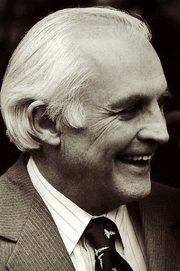Ernst Freese
Ernst Freese | |
|---|---|
 | |
| Born | September 27, 1925 |
| Died | March 30, 1990 (aged 64) |
| Alma mater | University of Göttingen |
| Known for | Molecular biology research |
| Spouse | Elisabeth Bautz |
| Children |
|
Dr. Ernst Freese (September 27, 1925 - March 30, 1990) was a molecular biologist who worked on the mechanism of
Education and academic career
Ernst Freese began his career as a student of physics with
Contributions to molecular biology
Freese was interested in the molecular mechanism of mutations and determined the difference between spontaneous and chemical mutations by using T4 phage. In 1959 he coined the terms "transitions" and "transversions" to categorize different types of point mutations.[2][3] Point mutations, often caused by chemicals or malfunction of DNA replication, exchange a single nucleotide for another. Most common is the transition that exchanges a purine for a purine (A ↔ G) or a pyrimidine for a pyrimidine, (C ↔ T).
Freese's research also included microbial differentiation and molecular neurobiology. He studied the effect of lipophilic acids on the growth and differentiation of bacteria. Freese's laboratory worked on the metabolic control of sporulation and germination of Bacillus subtilis bacteria. He identified the key metabolite for ignition of sporulation: a decrease of GTP. Freese was cofounder of the
Personal life
After meeting her at Caltech, Freese married his fellow postdoctoral fellow, Dr. Elisabeth Bautz, in 1956, and together they had two children, Katherine Freese[7] and Andrew Freese. After the death of Elisabeth, he married Katherine Bick, Ph.D. in 1985, who was the deputy director of Extramural Research for the National Institutes of Health.
References
- ^ "Ernst Freese, 64, Dies; A Molecular Biologist". The New York Times. April 4, 1990.
- PMID 16590424.
- .
- ^ Ernst Freese, ed. (1972). The Prospects of Gene Therapy. National Institutes of Health.
- Penguin Press. p. 101.
- PMID 2163003.
- ^ Curriculum Vitae of Katherine Freese
